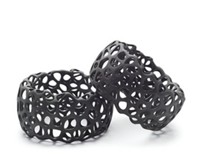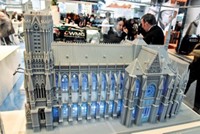Advertisement
Grab your lab coat. Let's get started
Welcome!
Welcome!
Create an account below to get 6 C&EN articles per month, receive newsletters and more - all free.
It seems this is your first time logging in online. Please enter the following information to continue.
As an ACS member you automatically get access to this site. All we need is few more details to create your reading experience.
Not you? Sign in with a different account.
Not you? Sign in with a different account.
ERROR 1
ERROR 1
ERROR 2
ERROR 2
ERROR 2
ERROR 2
ERROR 2
Password and Confirm password must match.
If you have an ACS member number, please enter it here so we can link this account to your membership. (optional)
ERROR 2
ACS values your privacy. By submitting your information, you are gaining access to C&EN and subscribing to our weekly newsletter. We use the information you provide to make your reading experience better, and we will never sell your data to third party members.
Materials
Specialties Bounce
Micro X tennis ball is a little ambassador for a transformed Akzo Nobel
by Rick Mullin
January 14, 2008
| A version of this story appeared in
Volume 86, Issue 2

LAST YEAR, Akzo Nobel made two big moves to complete a transformation that began in 2004 with the sale of some low-margin chemical businesses. The company sold its pharmaceuticals arm to Schering-Plough and then used the proceeds to acquire much of ICI. Akzo, once a diversified conglomerate making chemicals, paints, and drugs, emerged from 2007 as a coatings and specialty chemicals firm with the distinction of being the world leader in decorative paints.
In the midst of this transformation, the firm's New York City-based public relations firm issued a lengthy press release on ... tennis balls. While the announcement was timed to coincide with the U.S. Open last fall, sources at Akzo agree it can be viewed as at least a partial statement on the direction of the new Akzo Nobel.
The Micro X balls, manufactured by Tretorn in Sweden, are each filled with 700 million tiny, air-filled plastic cells from Akzo Nobel. The microcell material, called Expancel, was introduced in the late 1970s and has been used in applications ranging from textured printing ink to shoe soles.
Introduced by Tretorn 10 years ago, the tennis balls are a modest application for Expancel. But they also represent a specialty chemicals breakthrough in that they fall somewhere between the two traditional types of balls used in tennis—pressurized and unpressurized—and address problems with each.
Pressurized balls, which account for virtually all of the tennis balls sold in the U.S., are packaged in pressurized containers and tend to lose their bounce after only a few matches. Unpressurized balls, made of heavy rubber, last longer. But they are less responsive because it takes them longer to resume their shape after being hit by a racket or bounced from the court.
Unpressurized balls are more popular in Europe, where tennis balls cost more. There is also a cultural preference in Northern Europe for the less wasteful choice, says Joakim Appelqvist, sales and marketing director for Tretorn.
Expancel, which is manufactured by Akzo's pulp and paper division, is an archetypical performance material, according to Niklas Larsson, general manager for the product, and its use in tennis balls underscores the role of such materials in fostering innovation. "The tennis ball is not a huge product in terms of tonnage and volume," Larson says. "But it's a very good example of how our product can give customers an added value."
It is also a more dynamic showcase for the properties of Expancel than are its uses in drinking-cup insulation and running shoes. Larson explains that the microcells are made of acrylonitrile copolymer spheres filled with liquid hydrocarbon. When heated, the hydrocarbon converts from liquid to gas, expanding the cells from 10 µm to about 40 µm in diameter. They can be used in expanded or unexpanded form, or expanded in situ during product manufacture.
This flexibility opens the material up to a range of applications for customers, according to Larson. "We are experts in our process, and our customer is expert in its," he says, noting that environmental concerns drive much product innovation. "With Expancel you save cost. The product is lighter, which reduces transportation costs and saves on resources." In manufacturing, it allows faster machine speeds and shorter cycle times, he says.
AND IT MAKES for a good tennis ball, according to the International Tennis Federation, the London-based arbiter of such things. "We test size, mass, compression, and bounce height," says Jamie Capel-Davies, senior project technologist at ITF. "Tretorn's method ticks all the boxes and achieves a tennis ball-like performance." Micro X also constitutes a new category of ball. "In a sense, they are pressureless. But we put them in their own category, unique in terms of design."
Tretorn's Appelqvist sees plenty of room for growth for the Micro X ball. Pressurized balls comprise nearly 80% of the world market and well over 90% of the market in the U.S. He notes that Tretorn's main U.S. customers are cost-conscious operators of machines that shoot tennis balls in practice cages. That parsimony has not caught on with average players, however, who may not want to give up the distinctive feel of opening a pressurized can of fresh balls. The Micro X balls, which are also more expensive, are sold in basic plastic containers.
Tim van der Zanden, a communications manager for Akzo Nobel, agrees that Expancel is an important, if relatively small, part of the new Akzo Nobel. "We are no longer a pharma company or a conglomerate. Brand is more important now," he says. "A couple of years ago you would never have received a press release with a tennis ball."
According to Andrew A. Boccone, senior adviser at consulting firm CRA International and a longtime observer of the specialty chemicals industry, Akzo's experience with the Tretorn balls is emblematic of the sector in general. He notes that other diversified firms have exited fine chemicals and pharmaceuticals in recent years and begun to emphasize specialties, aggressively working with customers to develop new products based on performance materials.
Most such innovation involves the use of old materials, according to Boccone. "We haven't seen a lot of new blockbuster technologies." But one of the eternal truths about specialty chemicals is that what is old is new as long as a new use can be developed.
Larson says Akzo is on the lookout for customers with an eye for innovative opportunities—customers like Tretorn, where Appelqvist says Micro X balls were the brainchild of an engineer who had a "crazy idea" that the marketing department really loved. "Most of the time, it is the crazy ideas that become reality," Appelqvist says.




Join the conversation
Contact the reporter
Submit a Letter to the Editor for publication
Engage with us on Twitter